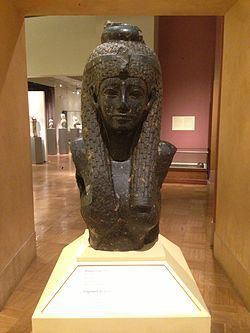 | ||
Dimensions 63.5 cm × 33.3 cm (25.0 in × 13.1 in) Similar The Death of Cleopatra, Cleopatra and Caesar, Nefertiti Bust, Paradise of Maitreya, (Untitled) Blue Lady | ||
The Bust of Cleopatra VII is a granite bust currently on display in the Gallery of Ancient Egypt at the Royal Ontario Museum (ROM). It is believed to have been discovered in Alexandria, Egypt at the site of Cleopatra's Sunken Palace on the island of Antirhodos. The bust was purchased by the ROM's founder Charles Trick Currelly while on expedition in Egypt in the early 1900s.
Contents
The Bust of Cleopatra VII can be found on Level 3 of the ROM in the Galleries of Africa: Egypt along with almost 2000 other Egyptian artifacts on display.
1960s
Egyptologist: Dr. Bernard Von Bothmer of the Brooklyn Museum, was the first expert to attempt to identify the piece and published his findings in an exhibition catalogue from 1960. On the subject of identification of such statues, Dr. Von Bothmer said "each sculpture has to be judged by style, rather than by attributes and accoutrements."
With no other previous scholarly literature available on the sculpture at the time, Von Bothmer concluded that: "If the date suggested (about 240-200 BC) is correct, we may have in this queen either Berenice II or Arsinoe III."
1980s
Dr. Robert S. Bianchi, also of the Brooklyn Museum, suggested the bust was either of a Queen or Goddess because "the appearance of the uraeus on the hair band is an attribute common to both." Bianchi thought a more precise identification would have been possible "had the annulets on the crown of the head been preserved."
With this research, evidence began to suggest that the statue belonging to the ROM had different characteristics when compared with other Ptolemaic statues from the 240-200 BC period. Dr.Bianchi's research challenged the first commonly accepted identification of the statue by dating the fragment to between 200 and 100 BC, and by giving merit to the possibility that the statue in fact depicts a goddess.
2000s - present
Dr. Sally-Ann Ashton of The Fitzwilliam Museum focuses on "the unusual extended back pillar with crown and the rounded portrait features, which on closer examination echo but do not exactly match those of early Ptolemaic period" in dating the statue.
Currently, the artifact label for the Royal Ontario Museum's statue of Cleopatra VII reads as follows:
Ancient Egyptian
Roberta Shaw, Assistant Curator of World Cultures at the Royal Ontario Museum suggest, "the statue probably stood outside some important municipal building. Perhaps a temple, perhaps the famous Alexandrian Library." The objects meaning within Ancient Egyptian culture stems from its role as a municipal statue. The small-sized nature demonstrates the statue would have been seen on a daily basis for the late Ptolemaic Egyptians, it would have been displayed at a level where the public could easily identify it as Cleopatra VII.
Modern day
The modern day significance of the statue can be found in the rarity and academic properties. In regards to rarity, Roberta Shaw states that "the ROM's statue of Cleopatra VII forms part of a pair," and is believed that "the sister statue resides in Alexandria." This pair is one of a kind, no other statues of this iconic ancient queen during the period 69 - 30 BC have been discovered. For this reason, the ROM's statue gives all the opportunity to examine Ptolemaic/Roman egyptianizing style of sculpture, establish a timeline to other period sculpture, and as Dr. Ashon states it "likely shows us the earliest representations of Cleopatra in two roles: queen and goddess of Egypt."
